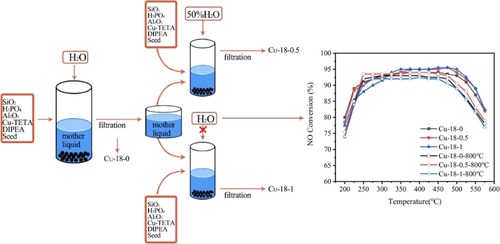当前位置:
X-MOL 学术
›
Ind. Eng. Chem. Res.
›
论文详情
Our official English website, www.x-mol.net, welcomes your
feedback! (Note: you will need to create a separate account there.)
One-Pot Synthesis of the Cu-SAPO-18 Catalyst Using Waste Mother Liquid and its Application in the SCR of NOx with NH3
Industrial & Engineering Chemistry Research ( IF 3.8 ) Pub Date : 2020-11-20 , DOI: 10.1021/acs.iecr.0c03826 Lei Guo 1 , Shujun Ming 1 , Shoute Zhang 1 , Qian Liu 1 , Lei Pang 2 , Peng Liu 1 , Zhen Chen 1 , Tao Li 1
Industrial & Engineering Chemistry Research ( IF 3.8 ) Pub Date : 2020-11-20 , DOI: 10.1021/acs.iecr.0c03826 Lei Guo 1 , Shujun Ming 1 , Shoute Zhang 1 , Qian Liu 1 , Lei Pang 2 , Peng Liu 1 , Zhen Chen 1 , Tao Li 1
Affiliation

|
A green and efficient way of synthesizing Cu-SAPO-18 was developed, which is characterized by the one-pot method and recycling of the mother liquid. All fresh samples synthesized with or without the mother liquid exhibit similar structural properties, Si/(P + Al), and particle sizes. However, all fresh catalysts show some differences in Brunauer–Emmett–Teller surface areas, Cu content, roughness of the crystal surface, and Si coordination. Temperature-programed desorption of ammonia, 29Si magic angle spinning nuclear magnetic resonance, temperature-programmed reduction experiments by H2, electron paramagnetic resonance, and UV–vis-diffuse reflectance spectroscopy results suggest that the mother liquid declines the content of acid sites, Cu2+ and CuO of Cu-18-0.5 and Cu-18-1. Therefore, Cu-18-0.5 and Cu-18-1 exhibit a decline in low-temperature activity but an increase in high-temperature activity, compared to Cu-18-0. During aging treatment, the mother liquid contributes to the movement of CuO to ion-exchange sites and new isolated Cu2+ ions are generated. However, excess mother liquid causes severe structural damage of Cu-18-1. Finally, Cu-18-0.5 exhibits the best hydrothermal stability owing to the more active Cu2+ sites and less structural collapse.
中文翻译:

所述Cu-SAPO-18催化剂利用废母液及其在NO的SCR应用的一锅法合成X与NH 3
开发了一种绿色高效的Cu-SAPO-18合成方法,其特征在于一锅法和母液回收。在有或没有母液的情况下合成的所有新鲜样品均显示出相似的结构特性,Si /(P + Al)和粒径。但是,所有新鲜催化剂在Brunauer-Emmett-Teller表面积,Cu含量,晶体表面粗糙度和Si配位方面均显示出一些差异。氨的程序升温脱附,29 Si幻角旋转核磁共振,H 2的程序升温还原实验,电子顺磁共振以及紫外-漫反射光谱法的结果表明,母液降低了酸性位点的含量,铜2+和Cu-18-0.5和Cu-18-1的CuO。因此,与Cu-18-0相比,Cu-18-0.5和Cu-18-1表现出低温活性降低但高温活性增加。在老化处理期间,母液有助于CuO向离子交换位点的移动,并生成新的孤立的Cu 2+离子。但是,过量的母液会导致Cu-18-1的严重结构破坏。最后,由于较高的Cu 2+活性位和较少的结构塌陷,Cu-18-0.5表现出最佳的水热稳定性。
更新日期:2020-12-09
中文翻译:

所述Cu-SAPO-18催化剂利用废母液及其在NO的SCR应用的一锅法合成X与NH 3
开发了一种绿色高效的Cu-SAPO-18合成方法,其特征在于一锅法和母液回收。在有或没有母液的情况下合成的所有新鲜样品均显示出相似的结构特性,Si /(P + Al)和粒径。但是,所有新鲜催化剂在Brunauer-Emmett-Teller表面积,Cu含量,晶体表面粗糙度和Si配位方面均显示出一些差异。氨的程序升温脱附,29 Si幻角旋转核磁共振,H 2的程序升温还原实验,电子顺磁共振以及紫外-漫反射光谱法的结果表明,母液降低了酸性位点的含量,铜2+和Cu-18-0.5和Cu-18-1的CuO。因此,与Cu-18-0相比,Cu-18-0.5和Cu-18-1表现出低温活性降低但高温活性增加。在老化处理期间,母液有助于CuO向离子交换位点的移动,并生成新的孤立的Cu 2+离子。但是,过量的母液会导致Cu-18-1的严重结构破坏。最后,由于较高的Cu 2+活性位和较少的结构塌陷,Cu-18-0.5表现出最佳的水热稳定性。











































 京公网安备 11010802027423号
京公网安备 11010802027423号